Hurling beautiful and intriguing imagery from global biomedical research at your eyes, every day of the year. BPoD.org.uk
Don't wanna be here? Send us removal request.
Text
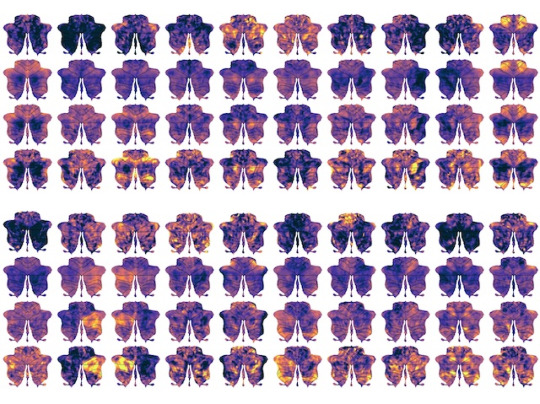
Backseat Driver
The brain region located at the lower back of the head called the cerebellum contributes vitally to many and varied functions such as in memory, language and motor skills, as it interacts with the cerebrum, the largest brain part. This study maps, using functional MRI scans, the functional connectivity developing between these brain regions in children from birth to aged five
Read the published research article here
Image from work by Wenjiao Lyu, Kim-Han Thung and Khoi Minh Huynh, and colleagues
Department of Radiology, University of North Carolina, Chapel Hill, NC, USA
Image originally published with a Creative Commons Attribution 4.0 International (CC BY 4.0)
Published in Nature Communications, July 2025
You can also follow BPoD on Instagram, Twitter, Facebook and Bluesky
#science#biomedicine#neuroscience#biology#brain#cerebellum#cerebrum#developmental biology#child development
2 notes
·
View notes
Text
Brain Protectors
Alzheimer’s disease, like other dementias, is characterised by memory loss, impaired cognition and mood changes. And, like other dementias, exercise can improve or stave-off these symptoms. Precisely how exercise provides such benefits is largely unknown, however. Through studies of a mouse model of Alzheimer’s disease, researchers have now identified some exercise-induced cell and molecular changes in the brain. One key change is the activation of a certain type of glial cell (orange) that produces unusually high levels of cadherin-4 (magenta) – a cell-to-cell adhesion protein thought to be involved in the development and support of the brain’s neurons. These glia were present at unusually low numbers in the model mice, were induced by exercise and, based on their transcription (the process of DNA being 'read' to become protein) profiles, seemed to promote cell survival. Human brain samples from Alzheimer’s patients also had lower numbers of these cells compared with controls, indicating the glia could be clinically relevant for targeted therapies.
Written by Ruth Williams
Image by Luis Moreira and Mass General Brigham; relating to work published by Joana F. da Rocha & Michelle L. Lance, et al
Cardiovascular Research Center, Massachusetts General Hospital and Harvard Medical School, Boston, MA, USA
Image originally published with no restrictions – Creative Commons Attribution 4.0 International (CC BY 4.0)
Research published in Nature Neuroscience, June 2025
You can also follow BPoD on Instagram, Twitter, Facebook and Bluesky

7 notes
·
View notes
Text

Diabetes Beaters
Pancreatic β-cells release insulin and faults in these cells underlie diabetes. This study in mice shows that treatment with a peptide (THR-123) that binds and activates a protein called BMP induces new production of β-cells and thus has potential as a therapeutic approach for insulin-dependent diabetes
Read the published article here
Image from work by Silvia Álvarez-Cubela and colleagues
Diabetes Research Institute, University of Miami Miller School of Medicine (UM-MSoM), Miami, FL, USA
Image originally published with a Creative Commons Attribution – NonCommercial – NoDerivs (CC BY-NC-ND 4.0)
Published in Nature Communications, July 2025
You can also follow BPoD on Instagram, Twitter, Facebook and Bluesky
4 notes
·
View notes
Text
Comeback Kidney
A thousand times smaller than water treatment plants, our kidneys balance the chemicals that sluice around inside our blood – removing waste, while helping to maintain water levels. The brain oversees this careful homeostasis, communicating with the kidneys using a combination of hormones and speedy signals carried by nerve cells [neurons]. Here, researchers investigate further, using sensitive light-sheet fluorescence microscopy to capture a developing mouse kidney in 3D. We see early neurons (highlighted in green) connecting up to the kidney's glomeruli (yellow) and blood vessels (pink). The team find that connections with different sets of nerves allow quick two-way communication between the brain and kidneys, helping to feedback and control their vital roles in mice and humans alike.
Video from work by Pierre-Emmanuel Y. N’Guetta and colleagues
Department of Cell Biology and Physiology, The University of North Carolina at Chapel Hill, Chapel Hill, NC, USA
Video originally published with a Creative Commons Attribution – NonCommercial – NoDerivs (CC BY-NC-ND 4.0)
Published in Cell Reports, October 2024
You can also follow BPoD on Instagram, Twitter, Facebook and Bluesky
8 notes
·
View notes
Text
Actin Excited
A cell's inner scaffolding or cytoskeleton of actin shapes their movements and is controlled by enzyme activity, but exactly how has been unclear. Here, complicated feedback mechanisms involving p21-activated kinase enzymes are revealed to underlie the excitability of the actin scaffold. In the video dramatic disruption of the cytoskeleton is seen when the p21-activated kinase inhibitor G5555 is added to the cell
Read the published research article here
Video from work by Joe J. Tyler & Anthony Davidson, and colleagues
Department of Pathology, University of Cambridge, Cambridge, UK
Video originally published with a Creative Commons Attribution 4.0 International (CC BY 4.0)
Published in Journal of Cell Science, June 2025
You can also follow BPoD on Instagram, Twitter, Facebook and Bluesky
15 notes
·
View notes
Text
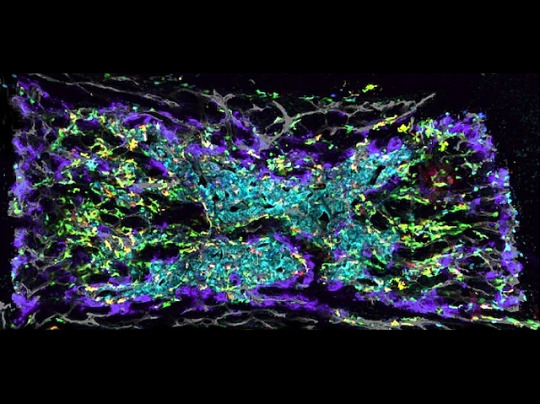
Bone Home
To encourage wildlife into your garden, you might make specialised nooks for different animals – a house for birds and a pond for frogs – to encourage them in. Developing bone marrow does something similar to invite immune cells, crafting tailored microenvironments for cells derived from the embryo's yolk sac to settle into after a brief stint in the early liver. But precisely how this recruitment happens was unclear, and understanding the process could explain childhood bone marrow syndromes and improve bone marrow engineering. A study found a type of blood vessel marked by a protein called VCAM1 guides stem and immune cells into place. When there, immune cells colonise particular areas of the bone marrow (pictured, mouse femur with different immune cell types coloured, unevenly distributed). Experiments showed that yolk-sac derived cells have different impacts on blood cell production in the liver and bone marrow, further showing the importance of location.
Written by Anthony Lewis
Image from work by Benjamin Weinhaus and colleagues
Division of Experimental Hematology and Cancer Biology, Cincinnati Children’s Medical Center, Cincinnati, OH, USA
Image originally published with a Creative Commons Attribution – NonCommercial – NoDerivs (CC BY-NC-ND 4.0)
Published in Nature Communications, May 2025
You can also follow BPoD on Instagram, Twitter, Facebook and Bluesky
4 notes
·
View notes
Text
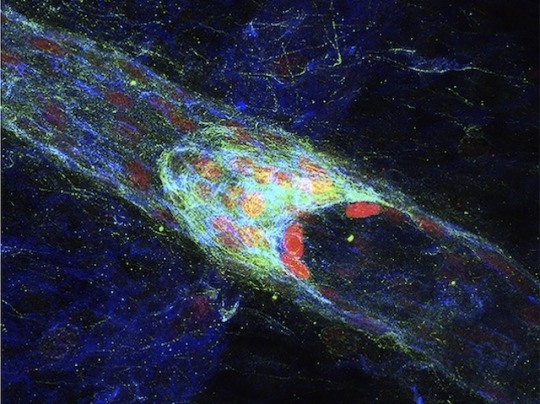
Directing Flow
Abnormal lymph node-like structures called tertiary lymphoid organs (TLOs) can develop in sites of disease or tissue dysfunction. This study in mice with ileitis (inflamed small intestine) finds that a molecule called S1PR1 in cells of lymphatic vessels (which transport fluid and immune cells) regulates the formation of vessel valves (one highlighted here) and of TLOs
Read the published research article here
Image from work by Xin Geng and colleagues
Cardiovascular Biology Research Program, Oklahoma Medical Research Foundation, Oklahoma City, OK, USA
Image originally published with a Creative Commons Attribution 4.0 International (CC BY 4.0)
Published in Journal of Experimental Medicine, June 2025
You can also follow BPoD on Instagram, Twitter, Facebook and Bluesky
2 notes
·
View notes
Text
Crowd Control
Living tissues develop to an overall pattern, carefully coordinating their crowds of cells in time and space. But how? Here researchers examine this morphogenesis, highlighting thousands of nuclei in jostling cells in a developing zebrafish’s retina with different colours, using a combination of microscopy and image analysis. Early in development, nuclei are oval shaped and loosely arranged in the tissue. In this older retina, developing layers become crowded with cells. Their nuclei change shape, becoming more rounded, potentially helping cells to pack together into the regular arrangement required in the overall organ. These developmental milestones suggest zebrafish could provide (even more) clues to organogenesis in genetically similar organisms, like humans, who share over 70% of their genes.
Written by John Ankers
Video from work by Lucrezia C. Ferme and colleaguess
Gulbenkian Institute for Molecular Medicine, Oeiras, Portugal
Video originally published with a Creative Commons Attribution 4.0 International (CC BY-NC 4.0)
Published in Science Advances, May 2025
You can also follow BPoD on Instagram, Twitter, Facebook and Bluesky
5 notes
·
View notes
Text

Head Sore Trails
The confluence of olfactory (smell) nerves, cerebrospinal fluid and ethmoid (between brain and nasal cavity) bone marrow in the skull is a dynamic immune microenvironment – insights for understanding and treating neuroinflammatory disease
Read the published article here
Still from video from work by Collin J. Laaker and colleagues
Department of Pathology and Laboratory Medicine, School of Medicine and Public Health, University of Wisconsin–Madison, Madison, WI, USA
Video originally published with a Creative Commons Attribution 4.0 International (CC BY-NC 4.0)
Published in Science Advances, June 2025
You can also follow BPoD on Instagram, Twitter, Facebook and Bluesky
#science#biomedicine#immunofluorescence#biology#brain#smell#bone marrow#nerves#neurons#inflammation#neuroscience
5 notes
·
View notes
Text
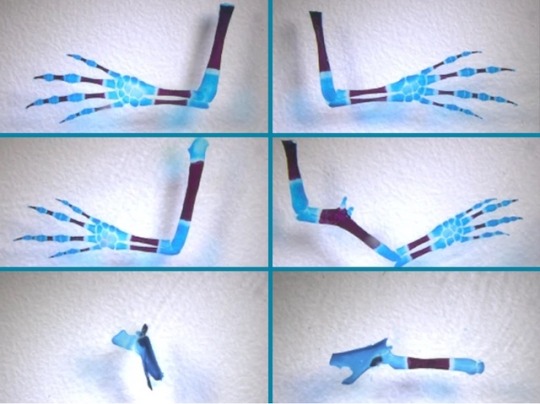
Right Foot Forward
If your toe got chopped off, you wouldn’t want a whole foot to grow back in its place. Neither would an axolotl, whose remarkable limb regeneration powers make this a more real possibility. Regenerating limbs retain their ‘proximodistal identity’ (ie. how far away they are from the body) thanks to genes that guide cells in the growing stump. Retinoic acid is known to regulate these genes, but how its levels are managed is unclear. Researchers hoping that axolotl biology could hold clues to improving human tissue repair discovered that the rate of retinoic acid breakdown is key. Reducing this breakdown led to structural errors, like regenerating the wrong limb segments (middle row), while fully blocking it caused regeneration to fail altogether (bottom). Understanding how positional identity is established is fundamental to tissue engineering and could even let us help the body repair and regrow without putting a foot wrong.
Written by Anthony Lewis
Picture is a compilation of image panels from work by Timothy J. Duerr and colleagues
Northeastern University, Department of Biology, Boston, MA, USA
Image originally published with a Creative Commons Attribution – NonCommercial – NoDerivs (CC BY-NC-ND 4.0)
Published in Nature Communications, June 2025
You can also follow BPoD on Instagram, Twitter, Facebook and Bluesky
11 notes
·
View notes
Text

Heart-tuning Channel
A molecule in the cells of developing of heart vessels called PIEZO2 responds to mechanical cues (pressure of blood and heart beat) is key to a critical phase of coronary vasculature remodelling. Loss of PIEZO2, part of a so-called ion channel, leads to vessels (highlighted in these pre-birth mice hearts in blue) misshaped and mis-branching (lower eight panels), and heart enlargement
Read the published research article here
Image from work by Mireia Pampols-Perez and colleagues
Molecular Pathways in Cortical Development, Max Delbrück Center for Molecular Medicine in the Helmholtz Association (MDC), Berlin, Germany
Image originally published with a Creative Commons Attribution 4.0 International (CC BY 4.0)
Published in Nature Cardiovascular Research, June 2025
You can also follow BPoD on Instagram, Twitter, Facebook and Bluesky
9 notes
·
View notes
Text
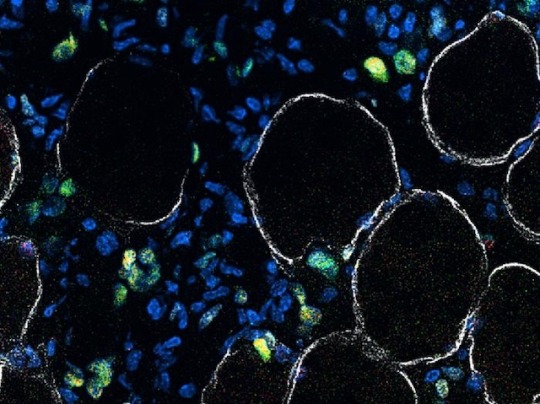
Sustaining Strength
In older people, muscle mass gradually diminishes leading to increased frailty. And, further exacerbating the issue, their capacity to repair and regenerate muscle after injury also declines. Similarly, mice lose muscle mass with age. But, according to recent research, muscle regeneration can be restored in such animals after treatment with prostaglandin E2 (PGE2) – a naturally occurring, hormone-like lipid involved in the regulation of inflammation, pain and tissue repair. The researchers found that PGE2 and its receptor EP4 are both decreased in the muscles of aged mice when compared with younger animals. Injection of a stable version of PGE2 alone, however, was sufficient to stimulate muscle stem cells (shown here in various states of differentiation – red, green, yellow), to regenerate muscle fibres (white), and to improve the animals’ strength. If such a treatment can be developed for humans, it could significantly improve the quality of people’s lives into old age.
Written by Ruth Williams
Image by Shiqi Su, Will Wang, Sanford Burnham Prebys; relating to work by Yu Xin Wang, Adelaida R. Palla & Andrew T.V. Ho, et al
Baxter Laboratory for Stem Cell Biology, Department of Microbiology and Immunology, Stanford School of Medicine, Stanford, CA, USA
Image originally published with no restrictions – Creative Commons Attribution 4.0 International (CC BY 4.0)
Research published in Cell Stem Cell, June 2025
You can also follow BPoD on Instagram, Twitter, Facebook and Bluesky
5 notes
·
View notes
Text
Deeper Resolve
Achieving super-resolution microscopy for deep tissue (at least 70 μm) imaging by cost-effective adaptation of two-photon laser-scanning microscopes
Read the published research article here
Video from work by Patrick Byers and colleagues
Multiphoton Imaging Lab, Munich University of Applied Sciences, Munich, Germany
Video originally published with a Creative Commons Attribution 4.0 International (CC BY 4.0)
Published in Nature Communications, June 2025
You can also follow BPoD on Instagram, Twitter, Facebook and Bluesky
5 notes
·
View notes
Text

Ticked Off
Ticks enjoy a blood feast. Burrowing under the skin they begin to guzzle, only dropping off – sometimes weeks later – once their guts are full. Here researchers using a high-powered microscope to capture the mesh of muscle fibres (highlighted in yellow with blue nuclei) which swell in their bellies during a meal. The team discover that a specific gene, called TNT, helps the gut to grow – but only in ticks with a healthy supply of cellular energy or ATP. Removing TNT prevents mitochondrial fission – stopping the tiny ATP 'factories' from forming. With ATP production hampered, the tick’s guts shrivel, limiting its feeding capacity. Reducing the tick’s thirst for blood is a step towards reducing their annoying bites, while also warding off tick-borne diseases.
Written by John Ankers
Image from work by Zhengwei Zhong and Kun Wang and colleagues
State Key Laboratory of Genetic Engineering, School of Life Sciences, Department of Infectious Diseases, Zhongshan Hospital, Fudan University, Shanghai, China
Image originally published with a Creative Commons Attribution 4.0 International (CC BY 4.0)
Published in Cell Reports, April 2025
You can also follow BPoD on Instagram, Twitter, Facebook and Bluesky
7 notes
·
View notes
Text
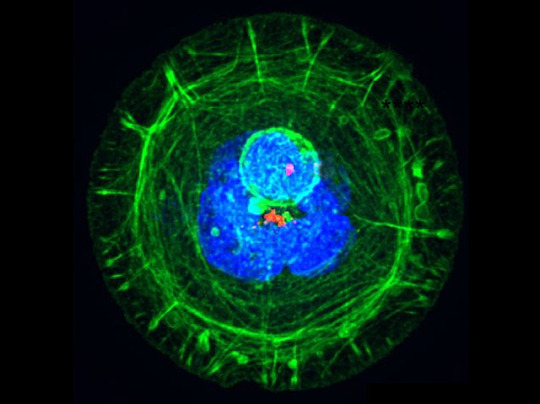
Inaction on Interaction
Acute myeloid leukaemia (AML) is a cancer originating from blood cell-forming progenitors of the bone marrow (BM). Unlike normal blood progenitors which polarise towards (thus changing shape) to engage with the nurturing BM substrate or stromal cells (the site known as the niche), AML cells interact with, but their contents fail to polarise towards, the niche. This finding has possible prognostic and therapeutic significance and implies an important role for polarisation in the normal state
Read the published research article here
Image from work by Khansa Saadallah and colleagues
CytoMorpho Lab, Human Immunology Pathophysiology Immunotherapy (HIPI), U976, Institut de Recherche Saint Louis (IRSL), Hôpital Saint Louis, Université Paris Cité, Paris, France
Image originally published with a Creative Commons Attribution 4.0 International (CC BY 4.0)
Published in EMBO Reports, June 2025
You can also follow BPoD on Instagram, Twitter, Facebook and Bluesky
#science#biomedicine#immunofluorescence#biology#cancer#acute myeloid leukemia#leukemia#cells#bone marrow
3 notes
·
View notes
Text

Small But Mighty
SARS-CoV-2 infects human cells using its surface spike proteins (one shown here, coloured blue). Neutralising antibodies – either produced naturally during infection, induced by vaccination, or lab-generated as monoclonal antibody (mAb) treatments – typically target this protein’s large, outermost S1 domain, rather than the small, less accessible S2 domain tucked behind. The S1 region is highly mutable, however, which partly explains why vaccines provide reduced protection over time and why existing mAbs have become largely ineffective. Now, there’s a new mAb (red) in the works – one that targets the far less mutable S2 region. To generate this mAb, scientists turned to llamas, which, like all camelids and unlike other mammals, produce tiny single-domain antibodies, or nanobodies, that can squeeze into places other antibodies can’t. Encouragingly, this new nanobody mAb had strong potency in culture against multiple variants of SARS-CoV-2 as well as SARS-CoV-1, and could significantly reduce viral load in SARS-CoV-2-infected rodents.
Written by Ruth Williams
Image from the Vlaams Instituut voor Biotechnologie; relating to work by Sieglinde De Cae et al
VIB Center for Medical Biotechnology, VIB, Ghent, Belgium
Image in the public domain
Published in Nature Communications, May 2025
You can also follow BPoD on Instagram, Twitter, Facebook and Bluesky
7 notes
·
View notes
Text
See Organoids Organise
Tracking brain organoid (lab-grown mini 'organs') development from fluorescent human induced pluripotent stem cells over weeks using live light-sheet microscopy reveals the progress of tissue morphology (shape, structure), cell behaviour and sub-cellular features
Read the published research article here
Video from work by Akanksha Jain & Gilles Gut, and colleagues
Department of Biosystems Science and Engineering, ETH Zürich, Basel, Switzerland
Video contributed by the authors under a Creative Commons Attribution 4.0 International (CC BY 4.0) licence
Published in Nature Communications, June 2025
You can also follow BPoD on Instagram, Twitter, Facebook and Bluesky
7 notes
·
View notes